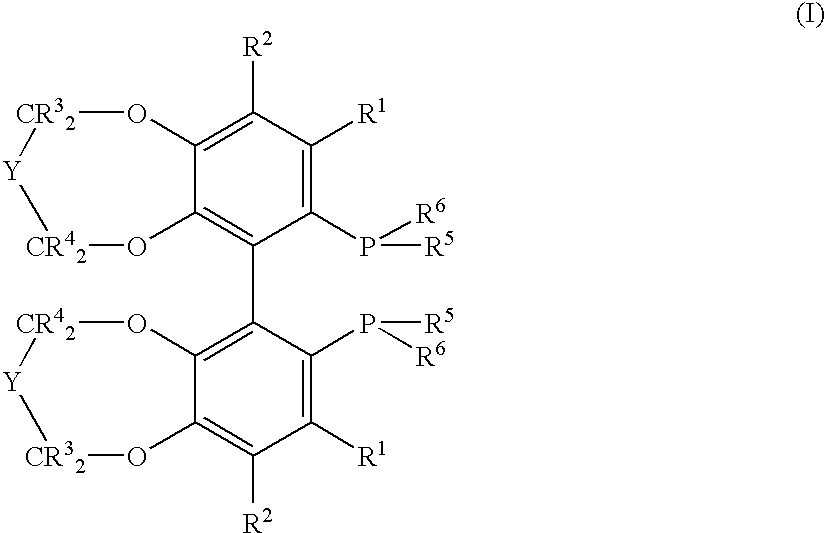Chiral C2-symmetric biphenyls, their preparation and also metal complexes in which these ligands are present and their use as catalysts in chirogenic syntheses
a biaryldiphosphine, c2-symmetric technology, applied in the direction of organic compound/hydride/coordination complex catalyst, physical/chemical process catalyst, ruthenium organic compound, etc., can solve the problem of reducing the possible yield of pure isomers, counteracting the desired effect or even being toxic, and none of the catalysts known from the prior art has yet been comprehensively met.
- Summary
- Abstract
- Description
- Claims
- Application Information
AI Technical Summary
Benefits of technology
Problems solved by technology
Method used
Image
Examples
example 1
Synthesis of 3,4-dihydro-2H-1,5-benzodioxepin-7-diphenylphosphine oxide (Hereinafter Referred to as DBO)
[0134] 6.05 g (248 mmol) of magnesium turnings together with 280 ml of tetrahydrofuran (THF) were placed in a 1 l three-neck flask provided with magnetic stirrer, reflux condenser, internal thermometer and dropping funnel under an argon atmosphere. While stirring, a solution of 55 g (240 mmol) of 7-bromo-3,4-dihydro-2H-1,5-benzodioxepin in 14 ml of THF was added dropwise over a period of 60 minutes and the temperature of the mixture was kept in the range 60-70° C. After stirring for 3 hours, the solution was cooled to 0° C. and 39.2 ml (205 mmol) of diphenylphosphinyl chloride were added dropwise over a period of 90 minutes, with the temperature being kept in the range from 0 to 10° C. The mixture was subsequently stirred at room temperature for 15 hours. At about 10° C., firstly 62 ml of water and then 72 ml of 1N HCl were added slowly and the mixture was subsequently stirred fo...
example 2
Synthesis of (±)-[6,6′-bis(3,4-dihydro-2H-1,5-benzodioxepin)-7,7′-diyl]bis(diphenylphosphine oxide) (Hereinafter Referred to as (±)-bis-DBO)-coupling
[0137] 18.4 ml (120 mmol) of diisopropylamine together with 95 ml of THF were placed in a 2 l four-neck flask provided with KPG stirrer, internal thermometer, dropping funnel and argon inlet under an argon atmosphere and 70 ml of n-butyllithium solution (1.6N in hexane, 106 mmol) were added at from −78 to −65° C. over a period of 60 minutes. After the addition was complete, the mixture was allowed to warm to −10° C. and was then cooled to −70° C. A solution of 35 g (100 mmol) of 3,4-dihydro-2H-1,5-benzodioxepin-7-diphenylphosphine oxide (DBO) in 880 ml of THF was added over a period of 4 hours while maintaining the temperature at −70° C. After the addition was complete, the mixture was allowed to warm to −40° C. over a period of 30 minutes and was subsequently cooled to −78° C., and a solution of 16.2 g (100 mmol) of iron(III) chloride...
example 3
Racemate Resolution of (±)-[6,6′-bis(3,4-dihydro-2H-1,5-benzodioxepin)-7,7′-diyl]bis(diphenylphosphine oxide)—Preparation of (+)-bis-DBO and (−)-bis-DBO
[0141] A solution of 1.43 g (4 mmol) of (−)-dibenzoyltartaric acid in 25 ml of ethyl acetate was added while stirring to a refluxing solution of 5.59 g (8 mmol) of (±)-[6,6′-bis(3,4-dihydro-2H-1,5-benzodioxepin)-7,7′-diyl]bis-(diphenylphosphine oxide) in 50 ml of dichloromethane. After refluxing for two hours, the mixture was cooled to room temperature, the precipitate was separated off and dried under reduced pressure (weight: 2.55 g). The mother liquor was evaporated and treated separately (see below).
[0142] The precipitate which had been separated off (2.55 g) was taken up in 25 ml of dichloromethane, admixed with 15 ml of aqueous NaOH (2N) and stirred for 2 hours. After the aqueous phase had been separated off, the organic phase was washed with 2×20 ml of aqueous NaOH (2N) and subsequently with saturated NaCl solution, dried ov...
PUM
| Property | Measurement | Unit |
|---|---|---|
| Metallic bond | aaaaa | aaaaa |
| Configuration | aaaaa | aaaaa |
Abstract
Description
Claims
Application Information
 Login to View More
Login to View More - R&D
- Intellectual Property
- Life Sciences
- Materials
- Tech Scout
- Unparalleled Data Quality
- Higher Quality Content
- 60% Fewer Hallucinations
Browse by: Latest US Patents, China's latest patents, Technical Efficacy Thesaurus, Application Domain, Technology Topic, Popular Technical Reports.
© 2025 PatSnap. All rights reserved.Legal|Privacy policy|Modern Slavery Act Transparency Statement|Sitemap|About US| Contact US: help@patsnap.com



